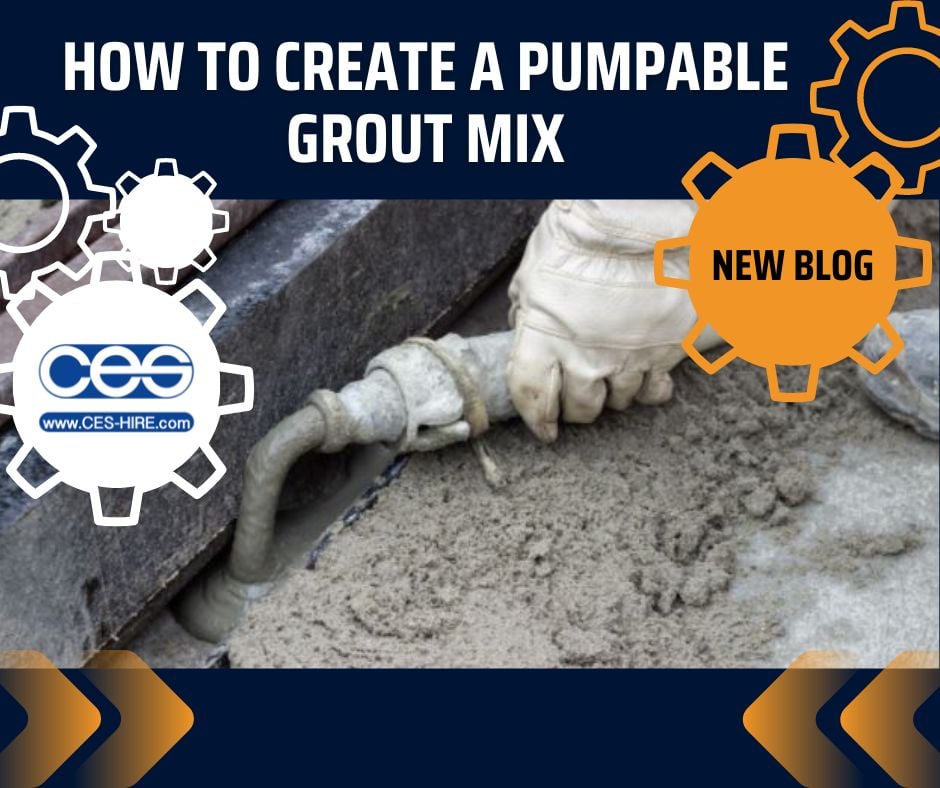 Add My Company
Add My Company
Sign In
How to Create a Pumpable Grout Mix
09-06-2023

Mixing your own grout/mortar can be a great way to keep costs down on your project. However, mixing your own material can have its challenges. Grouts are a delicate balance to achieve since they tend to have a thicker consistency yet still need to be flowable to make them pumpable. Materials with aggregate tend to be best to create a strong material though there are many other variables to consider such as water quantity, grading, pumping distance, hose diameter and additives. Read on to find out more about creating the perfect pumpable mix.
What are the challenges with mixing your own grout?
Grout Mix 1The main challenge with pumping your own grout mix, is the tendency for material separation. Grout is made up of sand, cement and water. Water is the only element in this trio that can naturally be pumped so in order to pump sand and cement, it needs to form a mixture in which the solid materials are surrounded by and lubricated by a cement paste. Whilst solid materials can be pumped in water at a high speed, the amount of water is limited within grout and often must be pumped at slower speeds due to the bore of pipelines or delicate grouting processes. Another challenge is getting the properties right for the application method. The mix of your material can vary depending on whether you are spraying onto a vertical surface, screeding off or trowelling by hand. Generally the higher the viscosity of the material, the less likely it is to separate, however the thicker the mix, the greater need for higher pumping pressure which can cause separation. So how do you get the mix right to avoid segregation of material?
Water Quantity
Whilst some people claim �wetter is better� in order to allow the product to flow, this is generally not the case. To produce a quality material, water content should be kept to a minimum, a thick batter consistency is a great way to describe it.. The incorrect quantity can simply cause separation of your mix. A great way to illustrate this separation when a mix is too wet is to remember that last time you were on a beach searching for the perfect sandcastle-building sand for the kids. When you squeeze sand that is too wet, you�ll find the water simply sieves through your hands and leaves a clump of sand in your hands. This is exactly what can happen with your grout and these �clumps� of solid dry material are likely to block your hoses. Water should also be clean and free of sulphates or other dissolved chemicals. Water is a particularly important component within grout as it is this element that combines with the solids to form the paste that bonds the other particles together. This paste will fill the voids between the larger solid particles and create the desired pumpable mix.
Aggregate and Grading
When it comes to your aggregate, for example sand, you need to consider the shape, size, ratio and grading. The proportion of elements such as sand in your mix is important . Cement sand ratio of 1:1 or 1:2 is unlikely to separate unless it is too wet, however the normal ratio is between 1:3- 1:6 and it is within this mix ratio that separation can occur. This is where grading your aggregate is crucial, this means your aggregate size steps down in size with an even mix of aggregate sizes, this helps the material bond together much better. With careful grading the paste that holds the grout together will be less likely to escape and the mix of aggregates sizing reduces the void spaces to be filled. Angular particle shapes are preferable for your grout mix as they give greater resistance, again preventing the paste escaping and therefore the mix separating.
Pumping Distance and Hoses
Grout Mix 2Ideally pumping distance should be kept to a minimum and hoses should be kept straight. Keeping your grout pump close to the area of work to allow material and water access for mixing and cleaning is useful if your project allows it. Your hose diameter will also have a bearing on material separation. A sudden reduction in hose diameter can increase pumping pressure and cause separation of material. Larger diameter hoses will allow the product to pump more easily; we would recommend around a 50mm hose for grout. Steel pipes will also have an advantage for pumping grout as there is less resistance with a metal pipe as opposed to a rubber hose.
Pumping Pressure
Grading your material also comes into play when considering your pumping pressure. If your sand/aggregate is not graded, the pressure applied to the water will be rapid but the sand will pack together and behave like a solid creating high frictional resistance. If pumping pressure is particularly high, material separation is more likely to occur. Piston pumps may have a tendency to separate more than other types of pump due to their fluctuating pressure. A sudden pressure difference (due to a change in hose diameter) can cause the paste to separate from the aggregate and leave a dry-packed plug of larger particles.
Additives
Some materials may contain accelerators to speed up setting and enable grout to strengthen rapidly. Once your material is mixed, keep it in motion and pump immediately so as not to block the hose/pump. Of course, the weather and temperature will have an impact on additives such as accelerator, with heat/sun decreasing the setting time further. You may wish to use other admixtures to modify or enhance your grout such as plasticizers, water-reducing agents or expansive agents. You should always have a good understanding of the impact such additives will have on your material consistency and refer to the manufacturers recommendations.
Tips for Mixing and Pumping
Prior to pumping you should rinse the mixer and charge the pump hopper with water to flush through the machine to remove residual material and subsequently drain this from the machine. Mix a slurry (a mix of cement and water to create a soup-like consistency) and pump through the machine to remove remaining residual water and lubricate the machine and hose. Never pump slurry through a dry hose. If you are unlucky enough to get a blocked hose, carefully remove it and flush it out with clean water. When beginning to mix your material, load 80% of the water anticipated and slowly add the cement with the mixer running. Mix to a creamy consistency before adding your filler material. Slowly add the sand until the mix just loses its cement colour. If you are opting for a premixed grout, always check the technical data to be sure it is pumpable and also determine the working time as it may not be long enough to allow you to pump.
For more information on How to Create a Pumpable Grout Mix talk to CES Hire Ltd
Enquire Now
List your company on FindTheNeedle.

